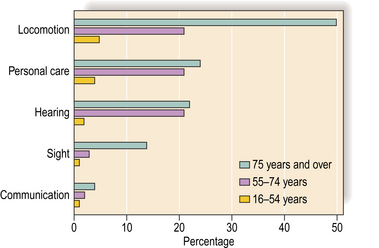Chapter 59 Physical disability
Physical disabilities are limitations in the ability to perform activities and can be the result of such diverse conditions as cerebral palsy, rheumatoid arthritis, stroke, multiple sclerosis or accidental injury. As shown in Figure 1, the commonest disabilities in western industrialized countries are in locomotion, personal care activities (such as dressing, washing, feeding and toileting) and hearing. Approximately 21% of adults and children in the UK report at least one limiting long-standing illness. The prevalence of disability increases with age; approximately half of those over 75 years have locomotion limitations.

Fig. 1 Prevalence of disabilities by age (percentage reporting each disability)
(adapted from Bajekal et al., 2001, with permission).



